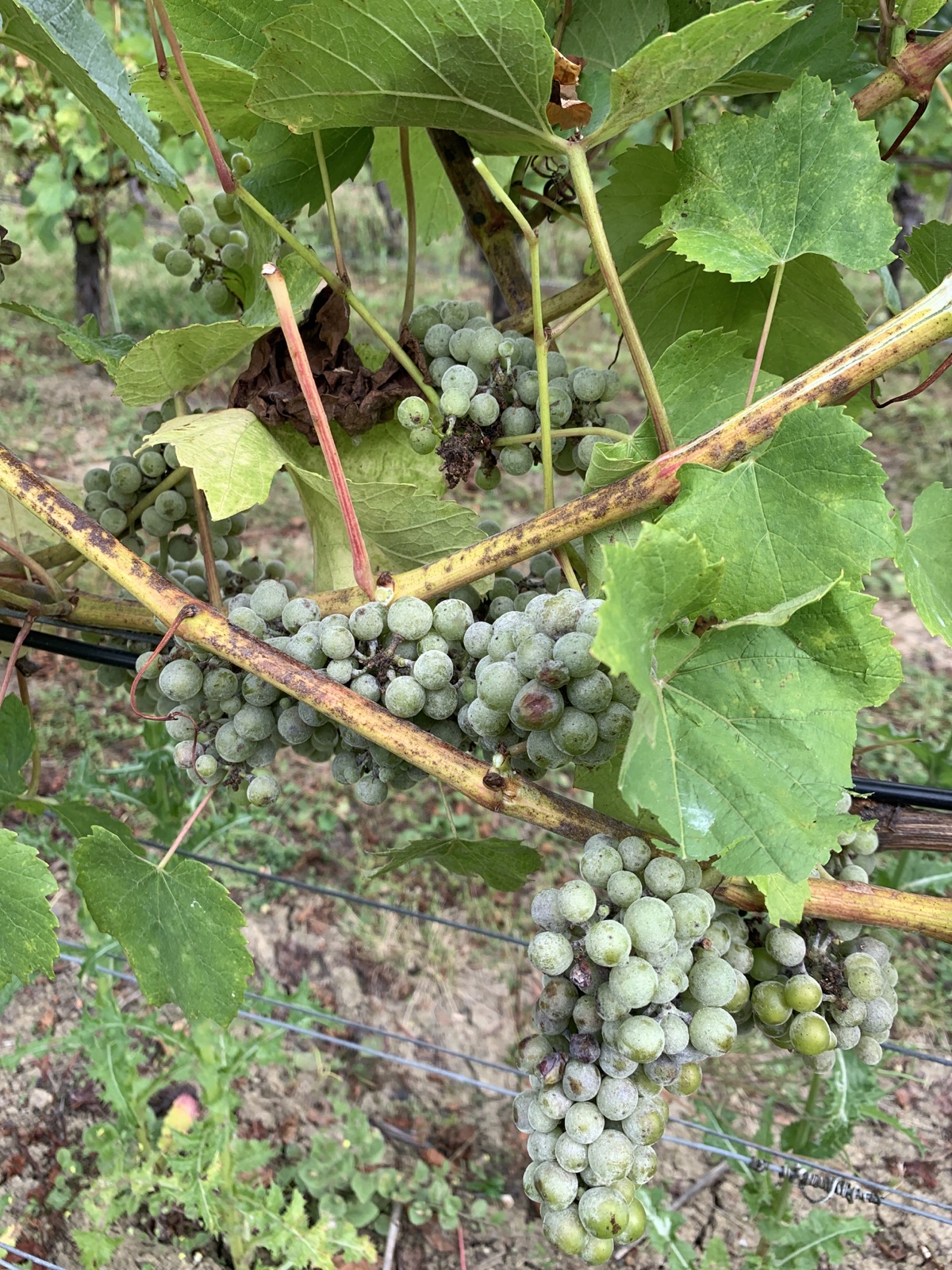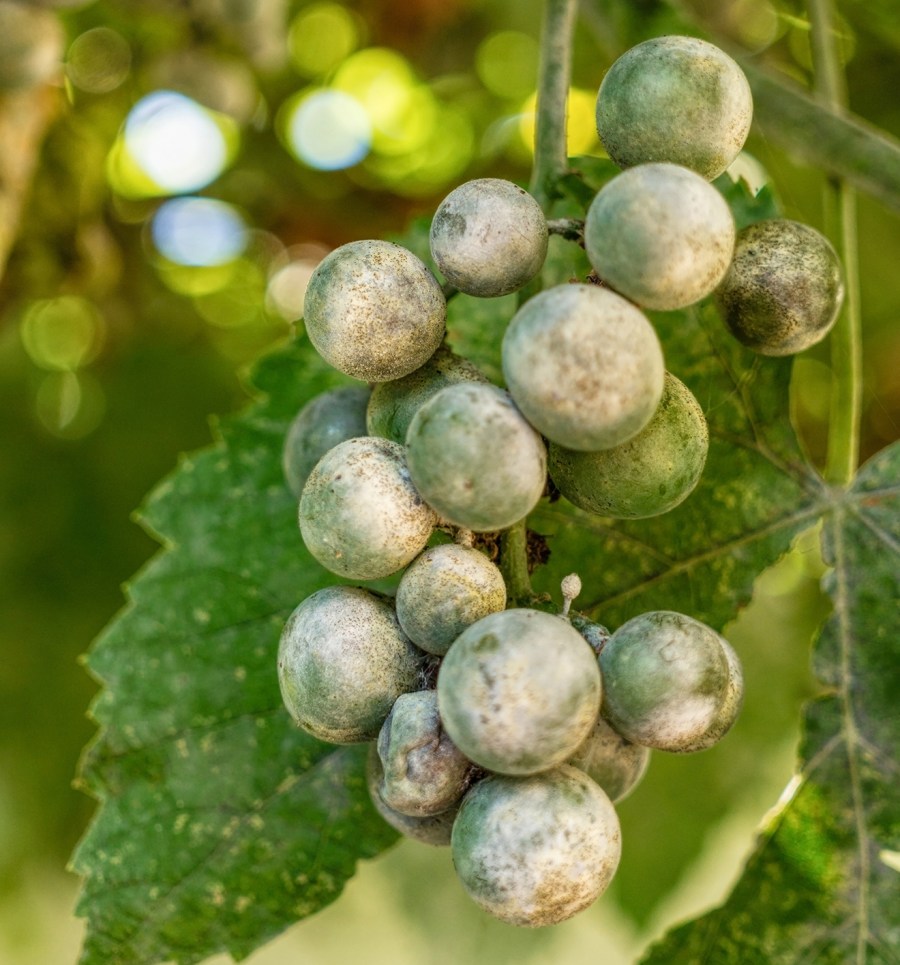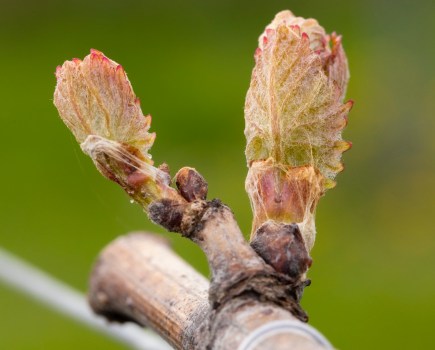Powdery mildew is a common and widespread fungal disease of vines and if left untreated on susceptible varieties it can have a devastating economic impact – with significant crop losses, reduced fruit quality and off-flavours in wine. Jo Cowderoy finds out how understanding the disease, using appropriate cultural methods, monitoring and the effective use of plant protection products can reduce its severity.
Powdery mildew is caused by the fungus Erysiphe necator, also known as oidium, and is believed to have originated in North America. It infects all green tissue on the grapevine including leaves, shoots and berries and has a pale ash grey powdery appearance. It can distort the growth of rapidly expanding leaves. Left unchecked, in favourable conditions, it can produce millions of spores and spread rapidly. Unfortunately, as with other fungal diseases, there is increasing incidences of fungicide resistance, where some products are no longer as effective.
Powdery mildew infection severity in a season is driven by the level of inoculum carried from the previous season, the weather conditions and good early season control. Sheltered areas of the vineyard and shaded canopies can provide conditions that favour the development of the disease.
Economic impact
Damage to leaves by powdery mildew reduces photosynthesis and therefore the production of sugars for the plant to grow and function – impacting the crop yield and quality. In fact, the vines can be affected for several seasons following infection and have reduced nutritional reserves. Even a minor infection on the berries can give off flavours in wine, so there is a risk of rejection by the winery.
Infected buds can have reduced viability and infection of inflorescences can reduce berry development, resulting in significant loss of yield. The skin of diseased berries is affected and can split allowing for secondary infections such as Botrytis. All these factors contribute to considerable economic losses.
Life cycle
Life cycle diagrams of powdery mildew in grapevines can be found easily in textbooks and on the internet and there are both sexual and asexual reproductive stages.
“It is important to understand the life cycle of powdery mildew as this gives a better chance to target the critical stages of infection and disease development,” explained Alex Valsecchi, Vineyard Manager, Albury Organic Vineyard. “Apart from the active part of the disease cycle, we know that spores overwinter on wood and debris around the vineyard so as part of the cultural practise the first control is probably done at pruning by choosing healthy canes. Removing prunings is good practice to reduce disease spreading, especially in an organic or biodynamic vineyard where we are limited on the pesticides we can use. So, removing prunings, chipping them in order to compost them (reaching temperatures of around 65°C will kill spores) and then bringing them back on the vineyard mixed into compost application is perhaps out best option. In a worst-case scenario, we can burn badly infected material.
Matt Strugnell, Vineyard Manager, Ridgeview Wine Estate, “removes infected shoots as soon as they are spotted. I try and select canes that have no visible signs of infection, that is no blotches or scarring, when pruning. I always remove canes from the vineyard – I used to burn prunings in the belief it would help but now I have a mulcher that collects them, and I take them away from the vineyard. Early spraying the following season is important.” Added Matt.
As well as overwintering spores in wood and debris, powdery mildew can survive in dormant buds which have been infected in the previous season. These buds then produce diseased and deformed shoots known as ‘flag shoots’, the following spring – and these can produce spores which infect the surrounding green tissue where the fungus multiplies. Spore numbers can increase dramatically if not effectively controlled.
Susceptibility
Vitis species differ in their susceptibility to powdery mildew, and it is generally considered that Vitis vinifera is particularly prone to infection – with one of the most susceptible varieties being Chardonnay. Hybrids are deemed to be less susceptible. “Having worked with many hybrid varieties in Canada I must say their resistance to mildew in general allows a more relaxed and routine approach to spraying programmes. As a generalisation the hybrids may require at least half the frequency of treatments compared to vinifera,” commented Jonathan Rodwell, Vineyard Manager, Vinescapes.
Piwis, are interspecific hybrids and the result of crossings between Vitis vinifera and other species of the genus Vitis. Piwi is short for Pilzwiderstandsfähig, a German term meaning disease-tolerant or fungal resistant. The aim of the breeding programmes is to develop varieties that meet future challenges in the vineyard – such as lowering the impact on the environment by reducing spray use and vineyard operations, as well as making quality wine. Piwi wines are already widespread in Germany and becoming increasingly popular in other countries, including the UK. There are apparently even plantings in experimental vineyards in Champagne – as they are varieties considered suitable for sparkling wine.
“European species have not evolved with American pests so, as such, simply hold no resistance, whereas the wild American vines do,” explained Sam Doncaster, a British-born viticulturist who spends much of his time working on vine breeding programmes in Germany and Switzerland. “In modern vine breeding there are probably several other Vitis species that hold a useful degree of resistance to varying fungal infections,” Sam added.
Piwi varieties have many advantages, including reduced use of pesticide sprays which is not only more sustainable environmentally but has substantial cost savings on products, energy, and labour; there is less soil compaction favouring soil health. They are higher yielding and earlier ripening.
“These have been around for a few years, but the significance is really hitting home now. Supposing you exchange about 40% of your V. vinifera with a Piwi that only requires 20% or 30% of previous chemical usage, then you get to halve your overall chemical use. Don’t forget the EU decree to ‘halve your chemical applications by 2030’ in viticulture,” commented Sam.
Cultural methods
Understanding powdery mildew and the conditions it favours enables the grower to employ cultural methods as well as Integrated Pest Management. According to the Sustainable Wines of Great Britain (SWGB) Integrated Pest Management (IPM) is an ecosystem approach to crop production and protection that combines different management strategies and practices to grow healthy crops and minimize the use of pesticides. In the SWGB IPM bulletin, it suggests that for some key pests, like powdery mildew, it is often better to protect from the disease than to eradicate it once it is established, with a preventative programme. For powdery mildew, it is best to focus on areas with a history of the disease or predisposing conditions – susceptible varieties, with vigorous, dense canopies in low lying, sheltered, shady, damp areas of the vineyard. The bulletin continues to emphasise the importance of monitoring and keeping eyes open for specific symptoms using systems like Sectormentor for recording. Also, WineGB South East publishes a guide to recognising grapevine symptoms – a useful addition to every vineyard tractor cab.
Chris Cooper, Fruit Agronomist with Hutchinsons and Retained Wine GB Technical Support, warns against: “Planting in shady damp areas that take a long time to dry out.” He recommends: “Growing highly tolerant cultivars, making sure the canopy management is sufficient to allow good air-movement and natural sunlight (UV) exposure, and trying not to allow the disease to establish.
“If there is a history of the disease in the vineyard or it gets established rogue out ‘flag shoots’ early in the season, use a robust spray programme and minimum 600lt/ha water volume, strip out very infected leaves, and target spray mostly on the bunches,” continued Chris.
“Don’t excessively feed with nitrogen but be guided by leaf analysis and select rootstock/scion vigour to suit the site, so thinner soils more vigour – whereas fertile soils less vigour. Obviously, this can’t be changed post planting,” he added
“Canopy management means vertically directed shoots, for a well aerated canopy,” explained Jonathan Rodwell. “Coupled with leaf pulling in the fruit zone, this will promote air flow, light penetration and spray penetration,” he continued.
“If high disease pressure has been experienced then all preventative measures need to be considered. Post-harvest and pre-bud break copper-based sprays are not necessarily common practice but where canes and dormant buds are well bathed in solution this can help significantly to reduce initial inoculums. Unfortunately, the practice of entering a vineyard with soil tillage at budburst can help to stir up overwintering spores and raise inoculum levels,” added Jonathan.
The aim is to create an environment less favourable for powdery mildew – which includes a reduction of the humidity level as much as possible. “My top tips are to maintain an open canopy, crown thin and shoot removal, where necessary, to improve air movement and light penetration,” said Alex Valsecchi. “Also vine trimming to maintain a controlled canopy – again to reduce shading and moisture trapping. We usually start leaf removal at flowering time with the eastern side and continue through the western side before pea size in a lighter way to start with, depending on the season, and a little more as the ripening progresses,” added Alex.
Matt Strugnell agreed: “Keep shade to a minimum – another reason for good canopy management, along with leaf stripping, well-timed tucking in, and trimming.”
To ensure there is minimal overwintering inoculum, Chris Cooper recommends, “good in-season cultural control of disease – and if it has got established burn the prunings. Most vineyards are all metal post and trellis these days so the over-wintering spores can no longer over winter in the wooden posts, hence pulverising prunings should be sufficient in the majority of vineyards,” he added.
Monitoring
Jonathan Rodwell comments that monitoring for powdery is not a visual control. “If you rely on this, you will probably be too late,” he explained. “It has to be considered in terms of a preventative programme with a close eye on rainfall, humidity and temperature,” he added.
Weather stations can be a useful tool as they collect data and can link to disease modelling or decision support systems to help the vineyard manager make decisions about crop protection and disease management. “Soil Moisture Sense doesn’t have expertise in diseases but does automatically link data to a system called RIMpro that has many disease models for vines and other fruit crops – in fact there are 20 different models for vines alone,” said Peter White of Soil Moisture Sense. “The weather stations can be designed with many different sensors, measuring temperature, humidity, leaf wetness and more. The positioning of weather stations is often dictated by the need to monitor for frost, but the lower areas of the vineyard will probably also be the areas that are cooler with higher humidity, and likely more favourable for powdery mildew,” he added.
“It is quite hard to monitor powdery mildew (compared to downy mildew) because there are several factors, in addition to weather conditions, that can affect it, such as variety, inoculum from last year, the plants vigour, foliage management, so we link to decision support tools (DSTs) explained Melissa Comellas, from Sencrop and a vineyard owner. “The decision support tools available in the UK for vines, which can all be accessed through the Sencrop application are – RIMpro and Sectormentor,” Melissa added.
“We do have a weather station,” explained Alex Valsecchi, “and we monitor weather parameters like temperature, humidity and leaf wetness but we do not have an alert system for pest and disease, we just keep our eyes open throughout periods of warm and dry weather alternated by precipitations. We regularly walk the crop especially in the areas of the vineyard we know are more prone to powdery. Usually, powdery develops in the top eastern corner of one of our Chardonnay blocks, and generally on the eastern side of the rows where the sun doesn’t shine until later in the day, so the leaves stay wet for longer. It is also one of the warmer spots and sheltered from the wind, so it is the perfect spot for powdery – and Chardonnay is very prone to it!” Alex added.
“I don’t really use technology for powdery monitoring other than keeping an eye on temperature and humidity. I crop walk regularly especially during periods of overcast warm weather. I usually spot it in the shadier parts of the canopy – a distorted shoot is a good sign. In my experience the period when the vines are most vulnerable is from pea size berries through to veraison,” commented Matt Strugnell.
Plant protection
Chris Cooper, Agronomist, recommends: “Mostly Thiopron and Unicorn at the start of the season and with known problem cultivars or sites. I suggest shortening the spray intervals if the infection is seen – adjust depending on the scouting reports. Use Justice, Vivando, Cosine from early flowering to veraison and just beyond, after that it depends on the control achieved. On non problem sites still Thiopron and Unicorn then let the strobilurins (Stroby, Nativo) and SDHI products (Sercadis, Filan) take the strain through flowering and beyond – using Justice if the conditions are very conducive to infection. Fortunately, I tend not to have major powdery mildew issues these days.
“There are alternatives to the usual fungicides for powdery mildew, and biological control products such as Amylo X, Romeo, Fytosave and Taegro, but in my experience they have given very inconsistent control where used – but we do resort to Potassium Bicarb (Karma) occasionally,” Chris added.
“In my experience spray programmes need to start early,” explained Jonathan Rodwell, “possibly at the 3-4 leaf stage, especially with susceptible varieties like Chardonnay. The timing of spray application needs to be flexible and reactive to seasonal pressure and conditions, such as humidity. In organic systems under high disease pressure, treatments can be frequent. With systemic sprays, do respect minimum intervals but be wary of the stated extended coverage – as fast-growing shoots and foliage and poor canopy management will erode protection capability,” Jonathan added.
“My spray strategy is quite simple – spray more frequently during periods of rapid growth and low light levels but be flexible and increase intervals if the sun is shining brightly, if there is low humidity and clear blue skies,” commented Matt Strugnell. “However, regular preventative spraying is essential especially if growing cultivars that are more susceptible, such as Chardonnay. Trying to eradicate powdery mildew is very difficult, stressful and time consuming. If a small infection is identified, then I act immediately – as I have seen it spread at an alarming rate,” Matt added.
“In organic viticulture we use Sulphur as the main preventative spray, this is used from pre-budburst throughout the growing season. If powdery appears we use Potassium Bicarbonate (Karma) as it is a good cleaner, we also use bio-fungicides like Romeo or ProS, which both seem to have some control,” explained Alex Valsecchi.
“Both on the organic and conventional disease pressure controls we see quite a number of products – more so on the continent than in the UK – where we have a more limited choice. Alternative products, if allowed, such as citrus oil, salt solutions and sodium bicarbonate should not be overlooked as additional tools of prevention. Additionally, not all sulphur-based products are equal, and persistency of effect can be variable.
“In colder climates we use wettable or aqueous sulphur solutions but that does not mean that if the temperatures are favourable, that dusting sulphur cannot be highly effective,” added Alex.
“It’s important to focus on fundamentals for disease control,” explained Jonathon Rodwell, “which in many studies have been found to be the stumbling blocks – such as correct calibration of sprayers, correct coverage of canopy and inflorescences or grape bunches. It’s vital to use spray indicator papers! The correct volumes need to be applied at the correct concentrations and a well-planned preventative programme sufficient to cope with high disease pressure,” he added.
The future
As well as breeding resistance into vines, to offer environmentally sound and cost-effective disease management methods, there are other technologies on the way. “I don’t have experience of the UV technology, but the information I have seen looks very promising,” commented Chris Cooper. “Technologies looking into drones or mechanised vehicles that will identify early disease establishment based on leaf chlorophyll sound promising as this will allow localised spraying or dosing to prevent the disease. Resistant cultivars using CRISPR gene technology and growing in tunnels are the more likely mid-term routes in the UK,” he added.
“On the monitoring front we are seeing much better coordination of local weather conditions being fed into disease models that also incorporate humidity and even aerial spore counts,” commented Jonathan Rodwell. “On the control side there is now some interesting equipment coming out of France and Italy for using UV and ozonated water. When this equipment is coupled with autonomous vehicles our capabilities for disease control should increase; traditionally in wet conditions and with high disease pressure, conventional tractor entry into the vineyards has been compromised,” Jonathan added.





